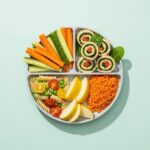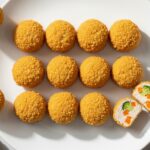Introduction:
Why Finger Foods Are a Game-Changer
Remember the days of meticulously spoon-feeding your baby? While purees are a great starting point, finger foods open up a whole new world of self-feeding and exploration. Finger foods are small, soft, and easily manageable pieces of food that toddlers can pick up and eat themselves. They empower your little>This isn’t just about convenience (though let’s be honest, that’s a definite perk!). It’s about fostering a healthy relationship with food from a young age. So, let’s dive in and discover how to make mealtime a fun and nutritious experience for your toddler.

The Wonderful Benefits of Finger Foods
Finger foods offer a plethora of benefits for your growing toddler:
- •Develop Fine Motor Skills: Picking up small pieces of food helps develop your toddler’s pincer grasp (using their thumb and forefinger), hand-eye coordination, and overall dexterity.
- •Encourage Self-Feeding and Independence: Finger foods allow your toddler to take control of their eating experience, fostering independence and a sense of accomplishment.
- •Promote Exploration of Textures and Flavors: Exposure to a variety of textures and flavors through finger foods helps expand your toddler’s palate and reduce picky eating habits later on.
- •Improve Chewing Skills: Chewing finger foods helps develop strong jaw muscles and prepares your toddler for more complex textures as they grow.
- •Foster a Positive Relationship with Food: By allowing your toddler to explore food independently, you’re creating a positive and enjoyable eating experience, which can lead to healthier eating habits in the long run.
- •Boost Confidence: Mastering the art of self-feeding boosts your toddler’s confidence and self-esteem.
- •Increase Appetite Awareness: When toddlers self-feed, they are more likely to listen to their internal hunger cues and eat until they are satisfied, promoting healthy portion control.
BLW Basics: A Quick Introduction
You might have heard of Baby-Led Weaning (BLW). While not strictly about only finger foods, it’s a philosophy that emphasizes letting babies and toddlers self-feed from the very beginning of their solid food journey. The core principle is to offer soft, age-appropriate foods in manageable sizes and allow your little>BLW is not for everyone, and it’s important to consult with your pediatrician before starting. However, incorporating elements of BLW, such as offering a variety of textures and allowing self-feeding, can be beneficial for all toddlers.
Safety First: Essential Rules for Finger Food Success
Before you start offering finger foods, it’s crucial to understand the safety rules to prevent choking hazards.
- •Always Supervise: Never leave your toddler unattended while they are eating.
- •Ensure Proper Seating: Make sure your toddler is sitting upright in a highchair or booster seat during mealtimes.
- •Start Slow: Introduce new foods>• Offer Soft Foods: Choose foods that are soft enough to mash easily between your fingers.
- •Cut Food Appropriately: Cut food into small, manageable pieces that are appropriate for your toddler’s age and developmental stage (more on this below).
- •Avoid Distractions: Turn off the TV and put away toys during mealtimes to help your toddler focus on eating.
- •Learn Basic First Aid: Take a CPR and choking first aid course for infants and children.
Choking Hazards to Avoid (and How to Modify Them)
Some foods are inherently more risky than others when it comes to choking. Here’s a list of common choking hazards and how to modify them:
- •Whole Grapes: Cut grapes into quarters.
- •Cherry Tomatoes: Cut cherry tomatoes into quarters.
- •Hot Dogs: Cut hot dogs into quarters lengthwise, then into small pieces.
- •Nuts and Seeds: Avoid whole nuts and seeds until your child is at least 4 years old. Nut butters should be spread thinly.
- •Popcorn: Avoid popcorn until your child is at least 4 years old.
- •Hard Candy: Avoid hard candy altogether.
- •Raw Carrots: Cook carrots until soft or shred them finely.
- •Apples: Cook apples until soft or shred them finely. Raw apple slices should be very thin.
- •Marshmallows: Avoid marshmallows.
- •Chewing Gum: Avoid chewing gum.
Cutting Food by Age: A General Guide
While every child develops at their own pace, here’s a general guideline for cutting food based on age:
- •12-18 Months: Foods should be cut into small, soft pieces about the size of your pinky fingernail. Think small cubes, thin strips, or shredded pieces.
- •18-24 Months: You can gradually increase the size of the pieces, but still ensure they are soft and easy to chew.
- •24+ Months: Continue to offer a variety of textures and sizes, but still be mindful of potential choking hazards.
12-18 Month Finger Food Ideas (with Steps!)
Here are 12 healthy and delicious finger food ideas perfect for toddlers aged 12-18 months:
- Steamed Sweet Potato Fries:
* Ingredients: 1 sweet potato * Steps: Peel and cut the sweet potato into fry-shaped pieces. Steam until soft. Let cool and serve. * Nutritional Benefits: Rich in Vitamin A, fiber, and antioxidants.
- Soft Cooked Broccoli Florets:
* Ingredients: 1 head of broccoli * Steps: Cut broccoli into small florets. Steam or boil until soft. Let cool and serve. * Nutritional Benefits: Excellent source of Vitamin C, Vitamin K, and fiber.
- Avocado Slices:
* Ingredients: 1 ripe avocado * Steps: Cut the avocado in half, remove the pit, and slice into thin strips. * Nutritional Benefits: Healthy fats, fiber, and potassium.
- Scrambled Eggs:
* Ingredients: 2 eggs, a splash of milk (optional) * Steps: Whisk eggs with milk (optional). Cook in a pan over medium heat, stirring constantly, until cooked through. Cut into small pieces. * Nutritional Benefits: Protein, choline, and iron.
- Shredded Chicken:
* Ingredients: Cooked chicken breast * Steps: Shred cooked chicken breast into small, manageable pieces. * Nutritional Benefits: Lean protein.
- Soft Cooked Carrot Sticks:
* Ingredients: 2 carrots * Steps: Peel and cut carrots into sticks. Steam or boil until soft. Let cool and serve. * Nutritional Benefits: Vitamin A and fiber.
- Banana Slices:
* Ingredients: 1 ripe banana * Steps: Peel and slice the banana into small, bite-sized pieces. * Nutritional Benefits: Potassium, fiber, and Vitamin B6.
- Pear Slices (Softened):
* Ingredients: 1 ripe pear * Steps: Peel and slice the pear into thin slices. Steam or lightly cook to soften. * Nutritional Benefits: Fiber and Vitamin C.
- Cooked Pasta Shapes (Small):
* Ingredients: Small pasta shapes (e.g., ditalini, elbow macaroni) * Steps: Cook pasta according to package directions. Let cool and serve. You can add a little olive oil to prevent sticking. * Nutritional Benefits: Carbohydrates for energy.
- Tofu Cubes (Soft):
* Ingredients: Firm or extra-firm tofu * Steps: Press tofu to remove excess water. Cut into small cubes. Lightly pan-fry or bake until slightly golden. * Nutritional Benefits: Plant-based protein and calcium.
- Cheese Cubes (Soft):
* Ingredients: Soft cheese (e.g., mozzarella, cheddar) * Steps: Cut cheese into small cubes. * Nutritional Benefits: Calcium and protein.
- Well-Cooked Ground Meat (Beef, Turkey, or Chicken):
* Ingredients: Ground meat * Steps: Cook ground meat thoroughly. Drain excess fat. Serve in small, crumbled pieces. * Nutritional Benefits: Iron and protein.
Snack Box Ideas: On-the-Go Goodness
Snack boxes are a lifesaver for busy parents! Here are some ideas for packing healthy and convenient snacks for your toddler:
- •The Rainbow Box: Include a variety of colorful fruits and vegetables, such as blueberries, raspberries, bell pepper strips, and cucumber slices.
- •The Protein Powerhouse: Pack hard-boiled egg slices, cheese cubes, and cooked lentils.
- •The Grain Goodness: Include whole-grain crackers, cooked quinoa, and a small container of yogurt.
- •The Fruit & Veggie Combo: Combine apple slices with peanut butter (spread thinly), carrot sticks with hummus, or banana slices with avocado.
- •The “Clean-Out-the-Fridge” Box: Use up leftover cooked vegetables, shredded chicken, or pasta.
Storage Tips for Freshness and Safety
Proper storage is essential for maintaining the freshness and safety of your toddler’s finger foods:
- •Refrigerate Perishables Promptly: Store cooked foods in the refrigerator within two hours.
- •Use Airtight Containers: Store food in airtight containers to prevent spoilage and maintain freshness.
- •Label and Date: Label containers with the date the food was prepared.
- •Follow “Use By” Dates: Pay attention to “use by” dates on packaged foods.
- •Discard Spoiled Food: If you suspect food has spoiled, discard it immediately.
- •Freezing Options: Many finger foods can be frozen for later use. Freeze in small portions for easy thawing.
Frequently Asked Questions (FAQs)
- My toddler gags when trying new finger foods. Is this normal?
* Yes, gagging is common when toddlers are learning to eat finger foods. It’s a natural reflex that helps prevent choking. However, if your toddler is truly choking (unable to breathe or cough), it’s important to know how to perform first aid.
- How do I know if my toddler is ready for finger foods?
* Look for signs of readiness, such as sitting upright unsupported, having good head control, showing interest in food, and reaching for food.
- My toddler is a picky eater. How can I encourage them to try new finger foods?
* Offer new foods alongside familiar favorites. Make mealtimes fun and relaxed. Don’t pressure your toddler to eat, but continue to offer a variety of healthy options.
- Can I offer my toddler the same foods I eat?
* Yes, but always ensure the food is cut into small, manageable pieces and is free of added salt, sugar, and unhealthy fats.
- What if my toddler refuses to eat anything but>Conclusion: Embrace the Mess, Enjoy the Journey!Introducing finger foods to your toddler can be a messy, exciting, and rewarding experience. Remember to prioritize safety, offer a variety of healthy options, and most importantly, have fun! Embrace the food-covered faces, the dropped pieces, and the occasional food fight. These are all part of the learning process. By following these tips and guidelines, you can help your toddler develop healthy eating habits and a lifelong love of food. Happy feeding!








